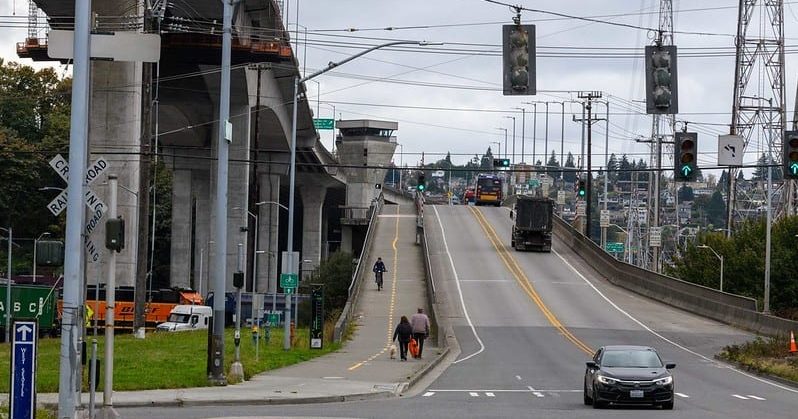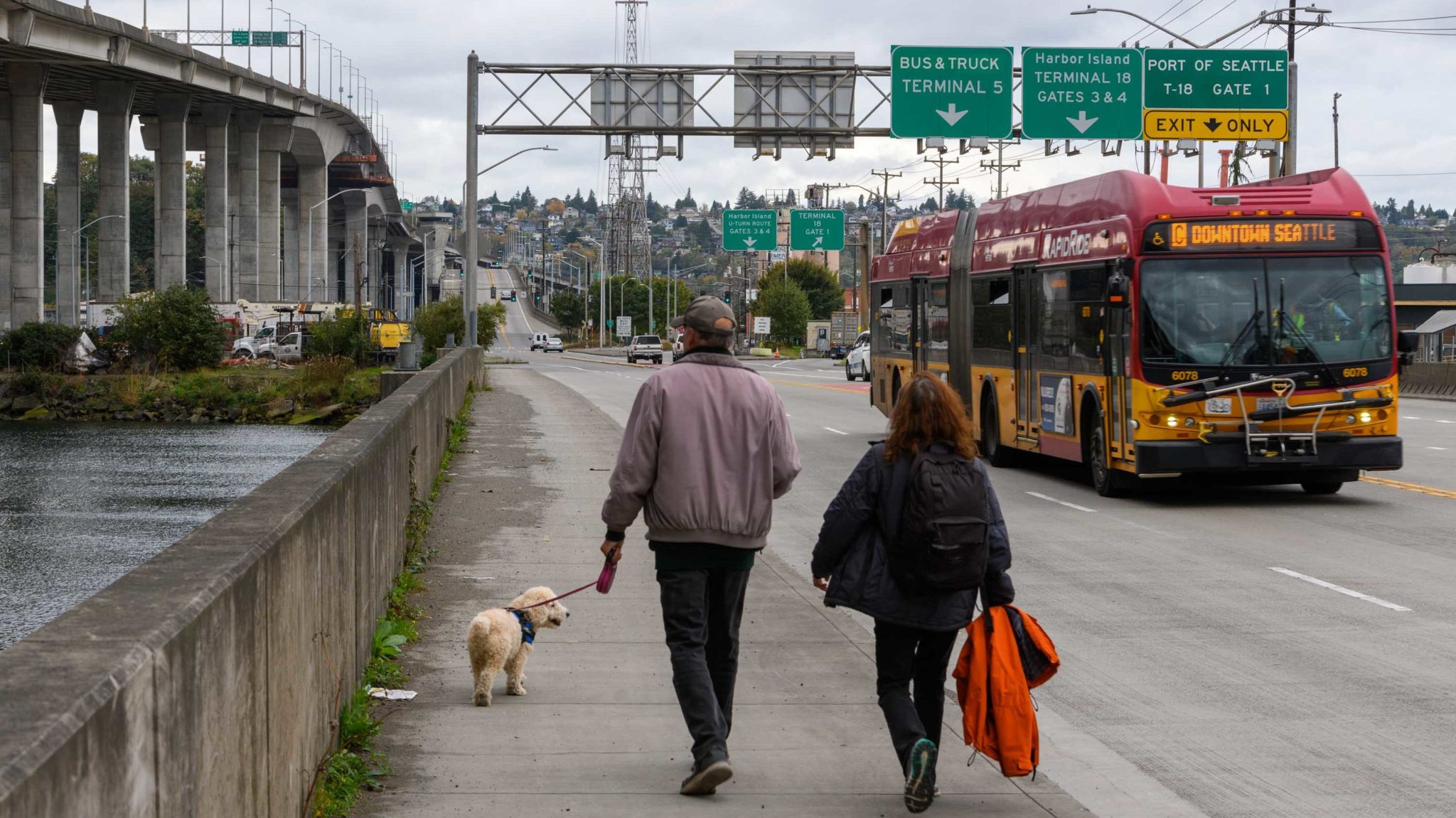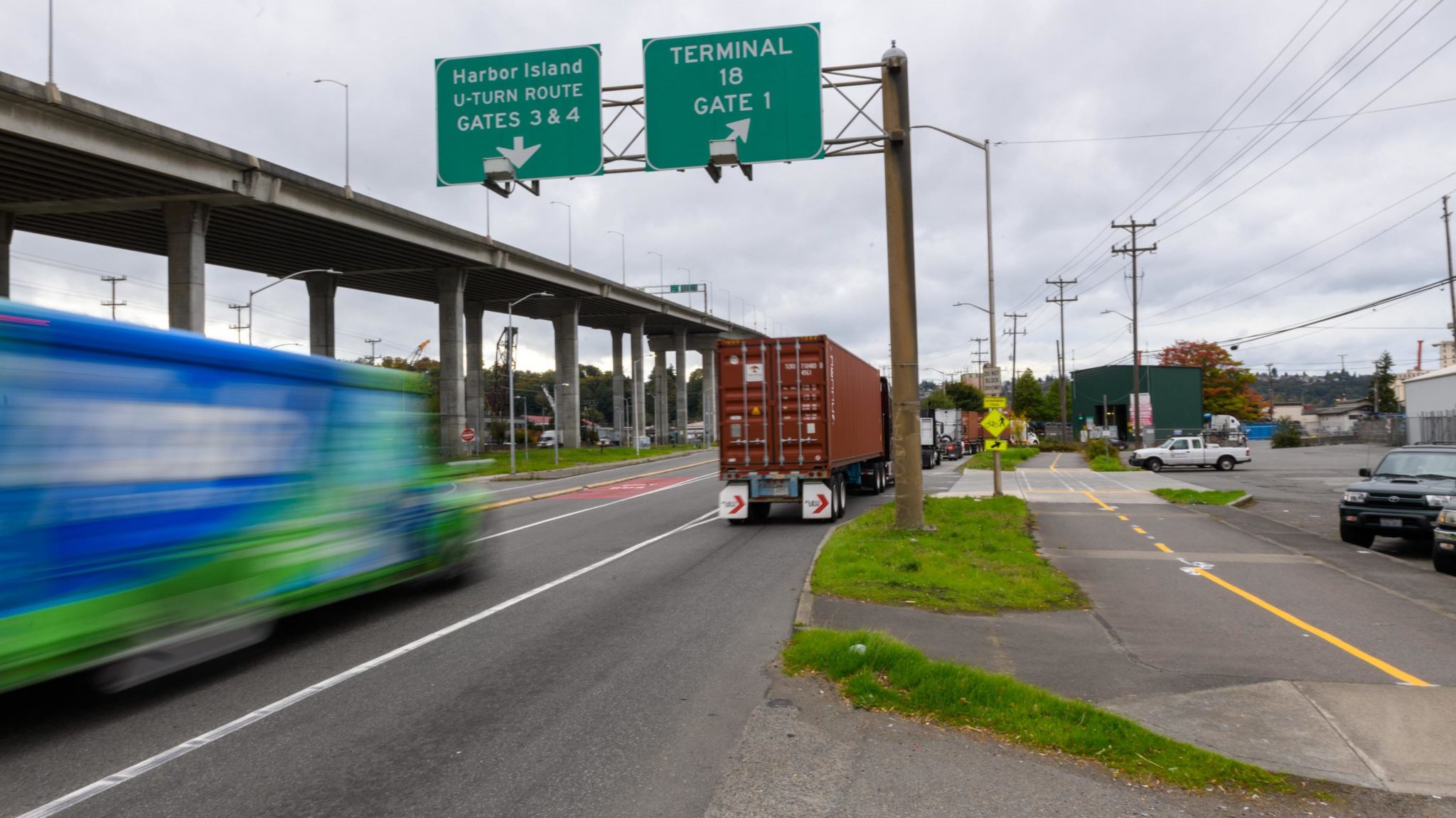 Please help us keep the Spokane St Swing Bridge (low bridge) clear for emergency vehicles, transit, and heavy freight. If you are not pre-authorized with license plate access to use the low bridge, you will receive a $75 citation every time you cross. Photo Credit: Tim Durkan.
Please help us keep the Spokane St Swing Bridge (low bridge) clear for emergency vehicles, transit, and heavy freight. If you are not pre-authorized with license plate access to use the low bridge, you will receive a $75 citation every time you cross. Photo Credit: Tim Durkan. There has been some confusion lately about how decisions are made regarding lower bridge access, and we want to help clear that up.
We knew that in order to ensure quick emergency response in West Seattle we had to limit the number of cars that could travel on the low bridge.
As with all decisions we make, we reach out to community to help us make those decisions.
In addition to regular discussion at community briefings and regular blog updates, we pulled together a group of community members to help advise the department in making decisions regarding traffic support while the West Seattle High-Rise Bridge was closed.
We used all that input to make decisions about access to the lower bridge. Decisions about access were made by SDOT and if you feel that others need critical access to the low bridge, we ask that you reach out to us. We are still open to hearing from community, and we ask that if you have those questions or concerns, that you email westseattlebridge@seattle.gov.
When we had to close the West Seattle High-Rise Bridge last March due to accelerated cracking, we knew this closure would be challenging for everyone. West Seattle residents, employees, and business owners are managing through an unprecedented situation, dealing with the high bridge closure, limited access to the Spokane Street Swing Bridge (low bridge), and struggling daily with the ongoing global pandemic. We cannot overstate how grateful we are for your patience and engagement.

After initially restricting access on the low bridge to allow only emergency vehicles, transit and freight vehicles, our evaluation showed we had additional capacity on the low bridge and could add a very limited amount of authorized vehicles.
To help us make tough decisions about low bridge access, we formed a West Seattle Bridge Community Task Force subcommittee to share their needs and perspectives, inform a dynamic policy and recommend an equitable approach. The subcommittee includes representatives from maritime industrial businesses, West Seattle-based businesses, laborers responding to dispatch, and medical providers, as well as government agencies. Working together, the subcommittee gave SDOT their input to develop criteria to allow a limited number of vehicles to make urgent and unplanned trips needed to move or acquire critical supplies or personnel.
The West Seattle business community is a valuable voice on the subcommittee. They are strong advocates for the needs of struggling businesses, the customers they serve and the broader West Seattle community. They are actively encouraging expanded access for healthcare workers, people seeking lifesaving medical treatment and many other community needs.
With the recent announcement from the Northwest Seaport Alliance that the Terminal 5 project will not be delivered until the end of the year, we anticipate that we will now be able to temporarily expand access to the low bridge for more users.
With the subcommittee’s continued guidance, we’ll work to expand the number of businesses that can use the low bridge for emergency supply runs. We also continue the effort underway now to provide authorized access for on-call staff working at health institutions; and our partners at the Department of Neighborhoods (DON) are helping us reach people seeking healthcare treatments, elders, and black, indigenous, people of color-owned small businesses. It’s important to know that SDOT makes the final access decisions related to the low bridge, not the community representatives volunteering on the subcommittee. SDOT makes these decisions based on data and community input, and is ultimately responsible for managing low bridge access.

We are all in this together and we are grateful for the community representatives that stepped up to help us all get through a challenging situation.
If you don’t feel heard and or feel that your need for access has not been addressed – that is something SDOT is responsible for, not the members on the subcommittee. We have been deliberately very conservative in our approach to the low bridge because we want to make sure that it is available for emergency vehicles when needed. But we are now in a position to temporarily grant more access and will continue to look to the input of the subcommittee – as well as other voices – to make the difficult decisions about who gets to use the low bridge. As a reminder, here’s been our approach:
- First, make sure emergency services can continue to serve West Seattle. We initially provided access for emergency vehicles, transit, and freight only. These users are still automatically approved to travel on the low bridge.
- Second, expand access to all users at night. Implement the SDOT recommendations (with support from the Community Task Force) to expand access to all vehicles at night between 9 PM and 5 AM, 7 days a week, as well as anytime access for public and private school buses.
- Third, pilot a program for some West Seattle businesses doing emergency supply runs, maritime and industrial businesses, Longshore union members and government vehicles through a physical placard program enforced by Seattle Police Department officers.
- Fourth, install auto-enforcement and collect data. An educational campaign launched and warnings were given the first couple of weeks after auto-enforcement was added. We started gathering data every day on how many vehicles use the low bridge and more importantly, what times they are using the bridge. We’re learning more about where we might have more opportunities to allow more vehicles to drive on the low bridge, without impeding emergency access.
- Next and ongoing, adjust and refine the access policy by working with the subcommittee and using data.
If we could allow everyone to cross the low bridge, we would. But that could lead to gridlock and affect critical emergency vehicle access. What we are doing is continuing to adjust our policy for low bridge access based on data and the community’s needs. If you have ideas for other groups to talk with, or other creative suggestions, please reach out to us at westseattlebridge@seattle.gov or call 206-400-7511.
Learn more:
- Email us with questions at westseattlebridge@seattle.gov.
- Visit the Spokane St Swing Bridge (low bridge) website